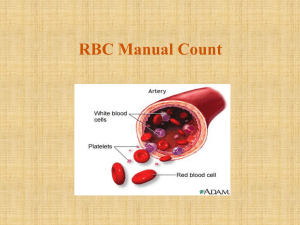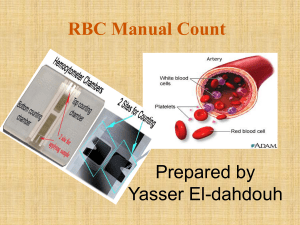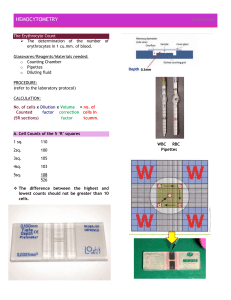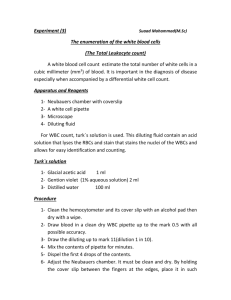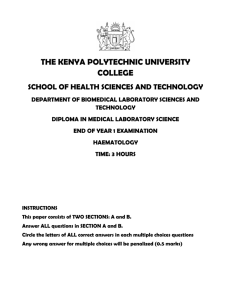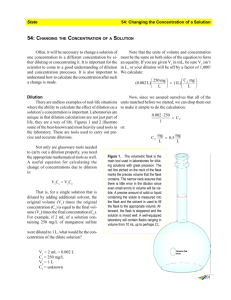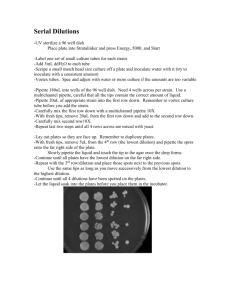Red Blood Cell
advertisement
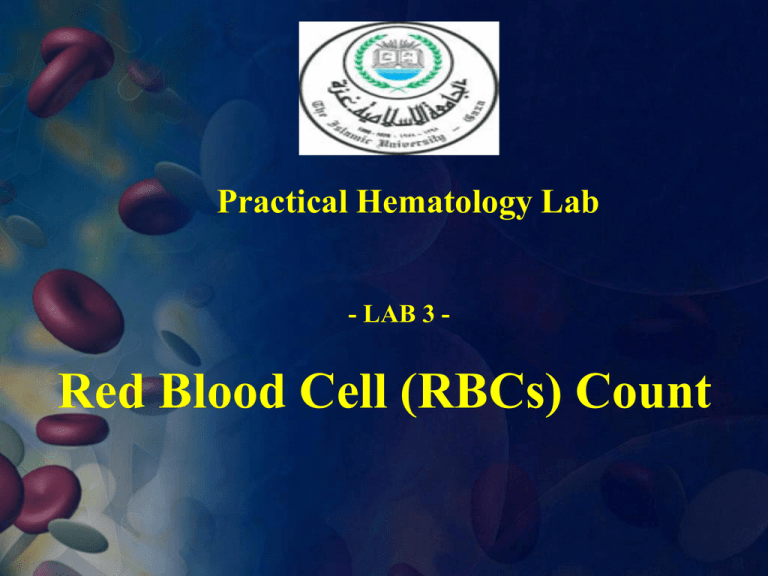
Practical Hematology Lab - LAB 3 - Red Blood Cell (RBCs) Count Introduction • Red blood cells make up almost 45 percent of the blood volume. • Their primary function is to carry oxygen from the lungs to every cell in the body. • Red blood cells are composed predominantly of a protein and iron compound, called hemoglobin, that captures oxygen molecules as the blood moves through the lungs, giving blood its red color. • As blood passes through body tissues, hemoglobin then releases the oxygen to cells throughout the body. • Red blood cells are so packed with hemoglobin that they lack many components, including a nucleus, found in other cells. RBCs Structure • The membrane, or outer layer, of the red blood cell is flexible, like a soap bubble, and is able to bend in many directions without breaking. • This is important because the red blood cells must be able to pass through the tiniest blood vessels (capillaries) to deliver oxygen wherever it is needed. • The capillaries are so narrow that the red blood cells, normally shaped like a disk with a concave top and bottom, must bend and twist to maneuver single file through them. Erythrocyte Count • Is the number of erythrocytes per micro litter of blood. • Normal Ranges: • Male 4.2 – 5.4 • Female 3.6 – 5.0 • New born 5.5 – 6.5 106/µL 106/µL 106/µL • Erythrocyte count increased in case of polycythemia and decreased in anemia. Erythrocyte Count • Principle: • In order to facilitate RBCs count a specified volume of blood is diluted with a specified volume of isotonic fluid. • Red cell diluting fluid must be: • anti-coagulant anti-hemolysis. • anti-aggregation. • anti-Rouleaux. • preserve RBC shape. Erythrocyte Count Diluting fluid: • One of the following solutions may be used: 1. Isotonic saline: • 0.85% sodium chloride (NaCl) in distilled water. 2. Hayam’s solution: • • • • Sodium Sulphate Sodium Chloride Mercuric Chloride Distilled Water 10g. 2g. 0.25g. 100ml 3. Gower’s solution: 1. Sodium Sulphate 2. Glacial acetic acid 3. Distilled water 4. Citrate-formalin solution: 1. Tri-sodium Citrate 2. Formalin 12.5 g. 33.3 ml 100 ml. Note: • In certain conditions, Hayam’s solution may cause clumping of RBCs and Rouleaux formations, while Gower's solution prevents these problems Sample: • Whole blood using EDTA or heparin as anticoagulant. Capillary blood may also be used. Equipments: 1. (Pipettes) used one of the following: Thoma pipette (RBCs) Micropipette –20l is the desired volume. 2. Improved Neubauer chamber with the cover slips. 3. Conventional light microscope. 4. Clean gauze. Procedure 1. Dilution of the blood: • Micropipette (20) 1:201 dilution. • Pipette 4.0ml of diluting fluid into a tube • Pipette 20l of will mixed anticoagulated whole blood to the tube. • Thoma red count pipette. • Draw the blood up to exactly the 0.5 mark and dilute to the 101 mark. • Mix continuously for 2-3 minutes. 2. Load the cleaned hematocytometer. 3. Place the hematocytometer on the microscope stage, lower the condenser. Procedure 4. Focus with x10 objective lens on the large central square. This square is ruled into 25 small squares, each of which is further divided into 16 smaller squares, of the 25 squares, only the four corner squares, and one middle square are used to count RBCs. 5. Switch to 40 objective lens, and start counting in the five designated squares. Calculations • Total RBC Count = • N x Dilution Factor x Volume Correction Factor Where: • • • N = the total number of red cells counted in the counting chamber. Dilution 1: 200 • Dilution Factor = 200 Counted Volume: • • • Each counted square has a volume of 0.2 X 0.2 X 0.1 = 0.004 5 squares volume = 5 X 0.004 = 0.02 cumm Volume correction factor = 1/0.02 = 50 So, • Total RBC count = • N X 200 X 50 = N X 10.000 Discussion 1. In certain conditions, such as polycythemia, the red blood cell count may be extremely high, which makes it difficult to obtain an accurate count. In this instance, make a larger dilution of blood. For a 1:301 dilution, add 20L of whole blood to 6.0mL of diluting fluid. 2. For a patient who has severe anemia and in whom the RBC is low, make a 1:101 dilution by adding 20L of whole blood to 2.0mL of diluting fluid. Discussion 3. Make certain the pipettes, hemacytometer, and cover glass are free from dirt, lint, and dried blood. Ensure that the diluting fluid is free from blood and other contamination. 4. RBC takes longer to perform than a WBC because of the larger number of cells. Therefore, proceed as quickly as possible once the cells have settled. Drying of the dilution in the counting chamber causes inaccuracies in the final cell count. 5. The range of error for a manual RBC is generally about 10 to 20%
